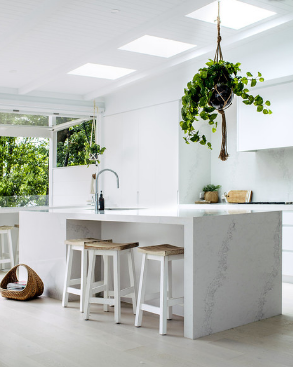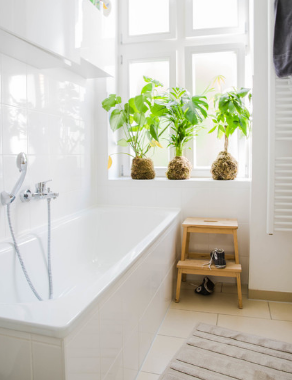

Houseplants of all shapes and sizes can brighten up a room, help improve air quality, and often bring more life to indoor spaces. How you present your houseplants – especially if you’ve accumulated a lot of houseplants – can have a big impact on whether your houseplant collection looks like an intentional part of the interior design or a random jungle (with its own unique charm). Check out these 10 ideas for potting, grouping, and showcasing houseplants that will bring new life to your overall room design.

By “personality” I mean its growth Xi and light requirements. If you already own this houseplant, research whether it prefers sunlight or whether it can tolerate darker areas before looking for potential planting locations. Once you’ve identified areas with strong light (direct and indirect), medium and low light, and plants that thrive with each exposure, make a note of the growth Xi and size of each plant.
Place “trailers” such as pothos and strings of pearls (Senecio) on elevated shelves so that they can be dropped. Place tabletop-sized plants close to sight, such as on a mantelpiece or mid-shelf, so you can see them up close. Reserve large structural plants, such as the lyre-leaf fig (Ficus lyrata) or the large cactus, for an open corner or a space behind a sofa.

Put it together Collect small containers into designated areas (such as benches, windowsills, or plant stands) to make them more attractive. In this apartment in Brooklyn, New York, small and medium-sized plants in mixed terracotta pots line up benches by sunny windows, looking more conscious than the same potted plants scattered around the living room. In addition, groups of plants are easier to water.

Build a theme – all succulents, white potted plants, baskets or colored containers – to blend together the look of the potted plants. This works well for grouping plant collections, like this arrangement in Austin, Texas, but can help integrate potted plants placed throughout the house.

You can also use duplicates in plant placement. For shelves, try to place the same number of plants on each level. Here, designers reuse in three ways (the same plant type, the same containers, and the same number of plants on each shelf) to create an orchid display that brings life to a small bathroom. Most orchids thrive in bright indirect light, as shown in the picture.

You don’t need to invest in a complex planting system to create a vertical garden. A metal lattice attached to the wall can provide a place to hang potted plants or for indoor vines to climb. In this attic in Barcelona, Spain, architects added metal lattices to the walls that spanned the floor and hung potted wood rhinoceros (Rhipsalis sp.) and staghorn ferns (Platycerium sp.). As a result, the exposed white walls become vibrant, tree-lined features.

Grab attention by hanging an eye-catching houseplant from the ceiling. Look for creeping varieties such as hoya, pothos, heart-shaped entanglement (Ceropegia woodii) or certain iris varieties that hang from the container. If there are no highlights with skylights, place hanging plants near the windows.

Another way to bring houseplants to bare walls is to install hanging pots. Systems like this often don’t have drainage holes (which can clutter up the interior), so you can put plants in nursery pots in containers for hanging systems. This has the advantage of keeping the arrangement flexible, allowing you to easily change plants.
You can find these suspension systems through a professional nursery or online, or assemble your own suspension system to support multiple potted plant hangers using positioning rods.

Using a floating shelf for houseplants is a great way to save floor space, combine smaller potted plants for a bigger impact, and keep small plants at eye level.
If you’re hanging a new shelf, place it near a window, such as a sunny area in your dining room or living room. Mix other natural objects, such as seashells, or use brass candlesticks, small sculptures, framed pictures, or other home accessories to create an vignette.

In this converted Victorian schoolhouse in Nottinghamshire, England, the owners removed the curtains from the laundry room and converted the lower poles into plant stands. Complete with potted orchids, basil, succulents, and other houseplants, this easily overlooked spot has become an attractive space.
Other areas that are often overlooked for houseplant growth include bookcase tops, shady corners, and oddly shaped corners.

Bathrooms Bathrooms often feel more natural by adding a plant or two to break up large areas of tiles and mirrors. Plus, most houseplants thrive with the extra moisture that comes with showering.
The designer of this house in London’s Hackney neighborhood used a skylight above the bathtub to hang potted donkey tail grass (Sedum morganianum), staghorn fern (Platycerium sp.), bunches of bananas (Senecio radicans) and ivy. As a result, the bathroom feels like a tranquil mini conservatory. Recreate this look with plants hanging from shower curtain rods or triple plants hanging from bathroom windows.

Replace potted plants with free-form balls made of moss and string to give houseplants a whole new look. You may have seen “kokedama”, a plant with wrapped root balls that form containerless hanging gardens – a Japanese art. While they are like works of art, hanging from windows or placed on windowsills like floating islands, they are very easy to make and care for.
When watering, soak the root balls in water and soak for a few minutes. Squeeze gently to release excess moisture. Repeat every few days or weekly, depending on root ball size, climate, and plant species.